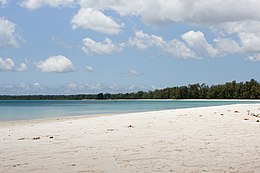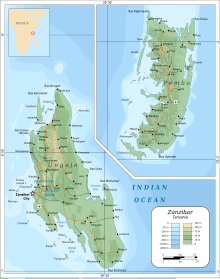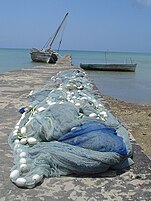geo.wikisort.org - Island
Pemba Island (Arabic: الجزيرة الخضراء al-Jazīra al-khadrā, literally "The Green Island"[citation needed]; Swahili: Pemba kisiwa) is a Tanzanian island forming part of the Zanzibar Archipelago, lying within the Swahili Coast in the Indian Ocean.
Nickname: الجزيرة الخضراء Al Jazeera al Khizra (the green island)[citation needed] | |
|---|---|
 Vumawimbi Beach, Pemba Island | |
| Geography | |
| Location | Indian Ocean |
| Coordinates | 5°10′S 39°47′E |
| Area | 988 km2 (381 sq mi) |
| Highest elevation | 119 m (390 ft) |
| Highest point | Masingini Ridge |
| Administration | |
Tanzania | |
| Region | Zanzibar |
| Capital city | Chake Chake |
| Largest settlement | Wete |
| Demographics | |
| Population | 406,808 (census2012) |
| Pop. density | 428/km2 (1109/sq mi) |
| Additional information | |
| Official website | Country website |
Geography

With a land area of 988 square kilometres (381 sq mi)[1] it is situated about 50 kilometres (31 mi) to the north of Unguja, the largest island of the archipelago. In 1964, Zanzibar was united with the former colony of Tanganyika to form Tanzania. It lies 50 kilometres (31 mi) east of mainland Tanzania, across the Pemba Channel. Together with Mafia Island (south of Unguja), these islands form the Spice Islands (not to be confused with the Maluku Islands of Indonesia).
Most of the island, which is hillier and more fertile than Unguja, is dominated by small scale farming. There is also large scale farming of cash crops such as cloves.
In previous years, the island was seldom visited due to inaccessibility and a reputation for political violence,[citation needed] with the notable exception of those drawn by its reputation as a center for traditional medicine and witchcraft. There is a quite large Arab community on the island, who immigrated from Oman. The population is a mix of Arab and original Waswahili inhabitants of the island. A significant portion of the population also identifies as Shirazi people.[citation needed]
The most important towns in Pemba are Chake-Chake (the capital), Mkoani, and Wete, which is the largest city. The centrally located Chake-Chake is perched on a mound with a view to the west on a bay and the tiny Misali Island, where the tides determine when a dhow can enter the local harbour. Pemba is, with the exception of a strip of land along its eastern coast, a very fertile place: besides clove trees, the locals grow mainly rice, coconut, bananas, cassava, and red beans (called maharagwe in the Swahili language).
Pemba is home to several dive sites, with steep drop-offs, untouched coral, and very abundant marine life.[2][3]
Islets
- Fundo - is located few miles from Wete. It is the only inhabited island among the group of islets forming the north-west reef of Pemba. The other islets there include Njao, Kashani, Kokota, Funzi, and Uvinje.
- Njao - is the northernmost islet on the Fundo group. It is mainly used for agricultural purposes.
- Kashani - is on the same reef as Fundo but on the southernmost tip close to Ras Mkumbuu.
- Kokota - is located at the southern mouth of Wete port.
- Funzi - lies east of Kokota and south of Uvinje island.
- Uvinje - is used for farming and located at the southern mouth of Wete port.
- Kiweni (Shamiani) - located on the south west part of Pemba, it is an uninhabited islet used mainly for farming and livestock grazing. On its southernmost tip it has a very fine beach and some prospective investors were building a hotel in the late 1990s.
- Kojani - is the only inhabited island on the western side of Pemba island. It is home to some skilled artisanal fishermen in East Africa who seasonally travel to most parts of the coast in search of schools of fish to catch.
- Kwata - the island was the site of the first major outbreak of cholera in 1978 when travelers were temporarily quarantined at this island before being allowed into Pemba.
- Makoongwe - is few kilometers from Mkoani. It has characteristics similar to the opposite area on the island of Pemba with deep soils and hilly terrain. Makoongwe is inhabited and people do farming and fishing.
- Matumbini - is an islet with dense mangrove forest and popular among fishermen due to the presence of rich coral reef.
- Misali - has a rich coral reef, and has been declared a marine reserve.
- Mwangi - is a small islet close to Mtambwe on the main island of Pemba.
- Panza - is the southernmost island in Pemba and in fact is a series of islets but a bridge connects the two main parts of Mtondooni and Panza proper. Its topography is coral on the Panza side and deep soil on the Mtondooni part. UFO wrecks found on the southern part has become an important diving site. Its inhabitants do farming and fishing.
- Vikunguni - is a small islet close to the north-west group of islands.
- Yombi - is a small islet east of Panza island.
Important Bird Area
Pemba has been designated an Important Bird Area (IBA) by BirdLife International because it supports populations of Pemba green pigeons, Pemba scops owls, Pemba white-eyes and Pemba sunbirds.[4]
Climate
Pemba has a tropical climate, yet somewhat milder than Tanzania's mainland and milder than in Unguja island. This climate is classified as "Aw" by the Köppen-Geiger system. The average temperature in Chake Chake is 25.5 °C (78 °F). The average annual rainfall is 1,364 mm. The monthly average temperatures are usually between 24 - 27.4 °C (75 °F - 81 °F). There are two rain seasons, with most rainfall coming between April and May and smaller rain season coming between November and December. Drier months are January - February, and a longer drier season between June to October.
| Climate data for Chake Chake | |||||||||||||
|---|---|---|---|---|---|---|---|---|---|---|---|---|---|
| Month | Jan | Feb | Mar | Apr | May | Jun | Jul | Aug | Sep | Oct | Nov | Dec | Year |
| Average high °C (°F) | 30.9 (87.6) |
31.6 (88.9) |
31.9 (89.4) |
30.1 (86.2) |
28.9 (84.0) |
28.5 (83.3) |
27.8 (82.0) |
28.1 (82.6) |
28.8 (83.8) |
29.7 (85.5) |
30.2 (86.4) |
30.8 (87.4) |
29.8 (85.6) |
| Daily mean °C (°F) | 26.8 (80.2) |
27.1 (80.8) |
27.4 (81.3) |
26.3 (79.3) |
25.3 (77.5) |
24.6 (76.3) |
23.7 (74.7) |
23.7 (74.7) |
24.1 (75.4) |
25.0 (77.0) |
25.9 (78.6) |
26.6 (79.9) |
25.5 (77.9) |
| Average low °C (°F) | 22.8 (73.0) |
22.7 (72.9) |
22.9 (73.2) |
22.6 (72.7) |
21.8 (71.2) |
20.7 (69.3) |
19.7 (67.5) |
19.3 (66.7) |
19.5 (67.1) |
20.3 (68.5) |
21.6 (70.9) |
22.5 (72.5) |
21.4 (70.5) |
| Average precipitation mm (inches) | 86 (3.4) |
71 (2.8) |
134 (5.3) |
304 (12.0) |
291 (11.5) |
74 (2.9) |
42 (1.7) |
27 (1.1) |
21 (0.8) |
54 (2.1) |
129 (5.1) |
131 (5.2) |
1,364 (53.7) |
| Source: Climate-Data.ORG[5] | |||||||||||||
Archaeology

Archaeological research on Pemba has shown its centrality to the Swahili coast trading system as early as 600 AD.[6] Along the northern coast, urban settlements at Chwaka later developed and flourished from the eleventh century to ~1500 AD.[7]
West of Pemba's capital Chake-Chake, on a long stretched peninsula called Ras Mkumbuu, one can find some of the oldest and best preserved series of early ruins on the islands (Ndagoni ruins, probably 14th century).[8]
East of Chake-Chake one can find the Mkama Ndume ruins at Pujini village (south of the airport) within easy reach by road from Chake-Chake. This is the only known early fortification on the whole Swahili Coast; it is dated to the fifteenth century.[9]
History


According to the Arab geographer Yakut, in the mid-13th century there were two independent sultans ruling over parts of Pemba Island.[10]
On 24 June 2016, the Australian Minister for Infrastructure, Transport and Regional Development, Darren Chester, said that a piece of aircraft debris was found on Pemba Island, possibly being from the missing Malaysia Airlines Flight 370.[11]
Administration

Pemba is part of the semi-autonomous Revolutionary Government of Zanzibar.[12] Administratively, it is divided into two regions, North Pemba (Pemba Kaskazini)with its capital at Wete,[13] and South Pemba (Pemba Kusini) with its capital at Mkoani.[14] Although the centrally located city of Chake Chake, near the airport, is considered Pemba's capital,[15][16] and is the seat of Pemba's court and the President of Zanzibar's official Pemba residence.[citation needed]
Economy
Fishing
Pemba is also famous for its rich fishing grounds. Between the island and the mainland there is the deep 50 kilometre wide Pemba Channel, which is one of the most profitable fishing grounds for game fishing on the Swahili Coast.[17]
Farming and agriculture
Pemba is (with the exception of a strip of land along its eastern coast) highly fertile for agriculture which serves the global farming industry.
Cash crops
A large segment of Zanzibar export earnings comes from cloves. The greatest concentration of clove trees in Zanzibar is found on Pemba (3.5 million trees), as growing conditions on the island are superior to those on Unguja island. Clove trees grow to a height of approximately 10 to 15 metres and can be harvested for sometimes over 50 years.[citation needed] Most of the island, which is hillier and more fertile than Unguja, is dominated by small scale farming. There is also large-scale farming of other crops, primarily rice, coconuts, and red beans (called maharagwe in Swahili), as well as cassava and bananas.
Land surveying
For the promotion of tourism, the Department of Surveys and Mapping at Chake-Chake has been publishing maps with tourist guides since 1992.[18]
Transport
Airport
Pemba Airport is also known as Wawi Airport or Karume Airport and connects the island to Arusha, Dar es Salaam, and Zanzibar City.
Gallery
- Island near Chake Chake
- A wharf at Mkoani during the daytime with fishing nets being dried in the sun
- An example of clove buds being dried in the equatorial sun
- Threadfin butterflyfish (Chaetodon auriga). Underwater photograph at Pemba island
- Sunburst butterflyfish (Chaetodon kleinii)
- Yellow teardrop butterflyfish (Chaetodon interruptus)
See also
- Geography of Tanzania
- Ghurabiyya Shia
References
- Tanzania in figures 2012, National Bureau of Statistics, Ministry of Finance, June 2013, page 7 Archived 2013-11-26 at the Wayback Machine
- "Africa: Dive of a lifetime on Pemba Island". 2 March 2010. Retrieved 11 March 2012.
- "Divernet: Fun at Fundu". Archived from the original on 17 October 2011. Retrieved 11 March 2012.
- "Pemba Island". BirdLife Data Zone. BirdLife International. 2021. Retrieved 27 February 2021.
- "Chake Chake". Retrieved July 26, 2017.
- Fleisher, Jeffrey; LaViolette, Adria (2013). "The early Swahili trade village of Tumbe, Pemba Island, Tanzania, AD 600–950". Antiquity. 87 (338): 1151–1168. doi:10.1017/S0003598X00049929. S2CID 163370129.
- LaViolette, Adria; Fleisher, Jeffrey (2009). "The Urban History of a Rural Place: Swahili Archaeology on Pemba Island, Tanzania, 700–1500 AD". International Journal of African Historical Studies. 42 (3): 433–455.
- Kirkman, James S. "Excavations at Ras Mkumbuu on the island of Pemba." Tanganyika Notes and Records 53 (1959): 161-78.
- LaViolette, Adria (2004). Swahili archaeology and history on Pemba, Tanzania: A critique and case study of the use of written and oral sources in archaeology. In Reid, Andrew M. and Paul J. Lane, eds. African Historical Archaeologies, pp. 125-162.
- Marina Tolmacheva, The Pate Chronicle (East Lansing: Michigan State University Press, 1993) p. 6
- "Potential MH370 debris found on island off African coast". The Washington Post. Associated Press. 24 June 2016. Archived from the original on 25 June 2016. Retrieved 24 June 2016.
- "The Constitution of The United Republic of Tanzania (PDF)". Centre for Human Rights, University of Pretoria. Archived from the original (PDF) on 2012-07-22. Retrieved 2009-09-01.
- "Tanzania Regional Profiles: Kaskazini Pemba Profile". The United Republic of Tanzania. 2016. Archived from the original on 14 November 2017.
- "Tanzania Regional Profiles: Kusini Pemba Profile". The United Republic of Tanzania. 2016. Archived from the original on 14 November 2017.
- "Pemba Surrounding Islands". Zanzibar's Airports Authority. Archived from the original on 19 September 2020.
- "A Trip to Pemba" (PDF). The Fumba Times. No. June–August, 2019. p. 8. Archived (PDF) from the original on 21 January 2021.
- "The Pemba Channel Fishing Club". Archived from the original on 25 April 2012. Retrieved 8 October 2011.
- Pemba - The clove island 1:100,000, Map & Guide, 3rd edition, 2013, Dept. of Surveys and Mapping, Box 235, Chake-Chake
External links
- Short documentary about Pemba Island on YouTube
- Audio interview with Pemba Island resident about life on Pemba Island
На других языках
[de] Pemba
Pemba (arabisch الجزيرة الخضراء al-Dschazira al-Chadra', DMG al-Ǧazīra al-ḫaḍrāʾ ‚die grüne Insel‘; römische Bezeichnung der Insel in der Antike: Pyralax[1]) ist mit 984 km² (Nord-Süd-Ausdehnung 67 km; Ost-West-Ausdehnung bis zu 22 km) und ca. 410.000 Einwohnern die zweitgrößte Insel des ostafrikanischen Sansibar-Archipels. Gemeinsam mit der 50 km südlich gelegenen Insel Unguja und zahlreichen kleinen Nebeninseln bildet Pemba den halbautonomen Teilstaat Sansibar in Tansania.- [en] Pemba Island
[es] Isla de Pemba
Pemba (en árabe, الجزيرة الخضراء, al-Dschazirat al-Chadra, ‘isla verde’) es una isla que forma parte del archipiélago de Zanzíbar, localizada cerca de la costa oriental de África, en aguas del océano Índico. Se sitúa a 50 km al norte de la isla de Unguja, y a otros 50 km de la costa africana. Las islas de Pemba, Unguja y la Isla de Mafia son las tres principales que conforman el archipiélago de Zanzíbar o Islas de las Especias.[fr] Pemba (île)
Pemba (en arabe : الجزيرة الخضراء al-Jazīra al-khadrā, c'est-à-dire « L'île verte ») est l'une des trois îles de l'archipel de Zanzibar en Tanzanie, le long de la côte africaine dans l'Océan Indien. Elle est située à 50 km au nord d'Unguja improprement appelée « Zanzibar », l'île principale de l'archipel séparée par le canal de Pemba de 50 km de la côte tanzanienne. Sa population était estimée en 2012 à 406 848 personnes sur une surface de 980 km2 (67 km sur 22). Sa capitale est Chake-Chake.[it] Pemba (isola)
Pemba, nota anche come Al Kuh Dra (l'"isola verde"), è un'isola della Tanzania, situata circa 50 chilometri a nord-est di Zanzibar, al largo della costa orientale dell'Africa, nell'Oceano Indiano. Dista circa 50 chilometri dalla costa.[ru] Пемба (остров)
Пемба (суахили и англ. Pemba) — коралловый остров в Восточной Африке, между 4°50' и 5°30' южной широты, в 50 км к северу от острова Занзибар. Отделяется от материка проливом Пемба. Принадлежит Танзании, куда вошёл в 1964 году вместе с островом Занзибар в составе автономии Занзибар.Другой контент может иметь иную лицензию. Перед использованием материалов сайта WikiSort.org внимательно изучите правила лицензирования конкретных элементов наполнения сайта.
WikiSort.org - проект по пересортировке и дополнению контента Википедии








